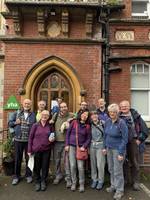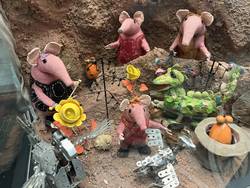"Whan that Aprill with his shoures soote The droghte of Marche hath perced to the roote Thanne longen folke to goon pilgrimages......" (Geoffrey Chaucer, prologue to CT)
Over 600 years later, it was November rather than April, but the urge to travel to far places in CYHA has never been subject to the constraints of time or season. It had been some time since we last visited the great city of Canterbury, its magnificent cathedral a centre for mediaeval pilgrimage, which played an enormous, if sometimes bloody, part in the history of our country.
For centuries, Canterbury was the desired destination for generations of citizens of England, most of whom rarely if ever had ventured from their own villages. Mediaeval pilgrims from all walks of life, various and diverse, as described by Chaucer (knight, prioress, wife of Bath, miller etc.) travelled from all over England, driven by a common purpose, to worship at the tomb of the martyr Thomas Becket in Canterbury Cathedral. Many others came from the far corners of Europe. All contributed to the wealth and prosperity of the city, taking accommodation in "hospitals" which provided hospitality for the pilgrims of old, much like the city youth hostel which accommodated our own motley band of "pilgrims."
Experience of the cathedral varied within our group. All had the opportunity to walk around its imposing exterior. Some went back to see it beautifully illuminated by night. I was fortunate to arrive early enough on Friday to study its grandeur from within, to admire the spectacular stained glass, soaring Gothic lines, fine stone work, and view the site of the murder which precipitated its position in the mediaeval world. For all our group, Saturday was spent in its powerful shadow, taking in all the historic ambience of the city, as Cressida led us on a fascinating walk through quaint, winding streets, past ancient buildings exuding history, intermittently following the course of the Stour as it flowed through the city centre, fading riverside gardens and picturesque houses lining its banks. We visited ancient churches, viewed imposing statues of the great and good of their day, like Queen Bertha on Lady Wooton's Green, contemplated some lovely old buildings, and curious ones like the "Crooked House".
Particularly vivid memories for me are of St Martin's church, earliest site of continuous Christian worship in Britain, and the atmospheric, autumnally melancholic riverside Franciscan gardens. Sunday saw us drive to Sandwich for an equally engaging, but more rural walk through fields, sand dunes and saltmarsh, again led by Cressida. We arrived back in the town in time for a visit to its fascinating Mediaeval Centre and very informative Guildhall museum.
The very pleasant town of Sandwich offered a good choice of venues for refreshment to fortify us to drive home, rejuvenated by our travels as the pilgrims of old. But a journey which took most of them weeks, even months, we could accomplish in a couple of hours. We should go again.
Doug
A Soup Dragon’s Tail
This is the planet Earth. It is a small planet wrapped in clouds, but for us, it is a very important place, it is home. But suppose we look away from the earth and travel, in our imaginations, across the vast starry stretches of outer space. Then we can imagine other stars, stranger stars by far...
Amongst the cultural and historical attractions of Canterbury, a highlight for some of us was a nostalgic visit to the Smallfilms Gallery in the wonderfully named Beaney House of Art & Knowledge. Oliver Postgate and Peter Firmin created iconic animations in a ramshackle former pigshed just outside Canterbury, including Noggin the Nog, Ivor the Engine, Bagpuss, and of course the Clangers. The pink knitted space-mice, nourished by blue string pudding and green soup harvested from the planet's soup wells, led some to ask if their creators used mind-altering substances - it was the 60s after all. But apparently, they got by on tea and biscuits. The museum has many of the original puppets and drawings, as well as the Meccano contraptions used for stop-motion filming.
And my souvenir of Canterbury? I declined the works of Chaucer, and bought "Clangers - The Complete Scripts 1969-1974". Amazingly, although they spoke in a language played on swannee whistles, their often-colourful words were scripted in full in English!
Dave P

